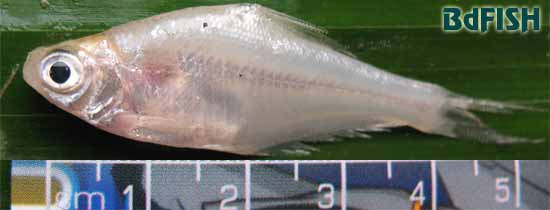
Systematic position:
Phylum: Chordata
Class: Actinopterygii (Ray-finned fishes)
Order: Cypriniformes (Carps)
Family: Cyprinidae (carp and minnows)
Genus: Osteobrama
Species: O. cotio cotio
Synonyms: Cyprinus cotio (Hamilton, 1822), Leuciscus cotio (Hamilton, 1822), Osteobrama cotio (Hamilton, 1822), Rohtee cotio (Hamilton, 1822), Abramis gangeticus (Swainson, 1839), Leuciscus gangeticus (Swainson, 1839).
Common names: Dhela, Mou, Moa, Keti (Bangladesh); Cotio (English).
Distribution: Throughout Bangladesh (Rahman, 1989). Pakistan; Assam, West Bengal, Bihar, Madhya Pradesh, Uttar Pradesh and Punjab (India); and Bangladesh (Talwar and Jhingran, 1991).
Conservation status: Endangered in Bangladesh (IUCN, 2000).
Morphology: Body deeply compressed. Dorsal and ventral profile almost equally convex. Mouth small and terminal with no barbels. Upper jaw slightly longer than lower jaw. Gill opening wide. Body silvery with dark on back. Fins are light greenish colored. Lateral line present and complete.
Head 35.7% SL and 27.8% TL. Height 42.9% SL and 33.3% TL. Eye 24% HL.
Fin formula: D. 10 (2/8); P1. 15; P2; 9-10; A. 33-36 (3/30-33) (Rahman, 1989).
Maximum length: Maximum length reported 15 cm (Day, 1878), 10 cm (Bhuiyan, 1964), 15 cm (Talwar and Jhingran, 1991) and 10.8 cm (Rahman, 1989 and 2005). Highest length measured 9.0 cm in the Chalan Beel of Bangladesh.
Food and feeding: Surface dweller fish and mostly feed on algae, protozoan, crustacean and aquatic insects (Shafi and Quddus, 1982).
Habitat: Bhuiyan (1964) described it as an inhibitor mainly of rivers, streams, beels and jheels of Dacca (presently Dhaka). Found in Freshwater rivers, ponds and lakes (Talwar and Jhingran, 1991). Recorded very rarely in Chalan Beel (Galib et al., 2009).
Breeding: Breeding time reported monsoon season (Bangladesh).
Economics importance: Used as food fish in Bangladesh and known to supply vitamin A to a great extent. Always marketed in fresh condition. Possibly a useful larvicide (Talwar and Jhingran, 1991).
Harvesting: Harvested using Veshal Jal, Kochal Jal and Khepla Jal (cast net) (Shafi and Quddus, 1982).
____________________________________________________
References:
Bhuiyan, A.L., 1964. Fishes of Dacca, Asiat. Soc. Pakistan, Pub. 1, No. 13, Dacca, pp. 1-148.
Galib, S.M., Samad, M.A., Mohsin, A.B.M., Flowra, F.A. and M.T. Alam. 2009. Present Status of Fishes in the Chalan Beel- the Largest Beel (Wetland) of Bangladesh, Int. J. Ani. Fish. Sci. 2(3): 214-218.
Hamilton, F., 1822. An account of the fishes found in the river Ganges and its branches, Edinburgh & London, Fishes Ganges, 405 p.
IUCN Bangladesh, 2000. Red Book of Threatened Fishes of Bangladesh, IUCN- The World Conservation Union, xii+, p. 116.
Rahman, A.K.A., 1989. Freshwater Fishes of Bangladesh, 1st edition, Zoological Society of Bangladesh, Department of Zoology, University of Dhaka, Dhaka-1000, pp. 123.
Rahman, A.K.A., 2005. Freshwater Fishes of Bangladesh, 2nd edition, Zoological Society of Bangladesh, Department of Zoology, University of Dhaka, Dhaka-1000, pp. xviii -263.
Shafi, M. and Quddus, M.A.A. 1982. Bangladesher Matshya Sampad (in Bengeli), Bangla Academy, Dhaka, pp. 1-444.
Swainson, W., 1839. The natural history and classification of fishes, amphibians, & reptiles, or monocardian animals. Spottiswoode & Co., London. Nat. Hist. & Class. i-vi + 1-448.
Talwar, P.K. and A.G. Jhingran, 1991. Inland Fishes of India and Adjacent Countries, Vol. I, Oxford & IBH Publishing Co. Pvt. Ltd. New Delhi-Calcutta, pp. 172-173.
Visited 3,818 times, 1 visits today | Have any fisheries relevant question?
